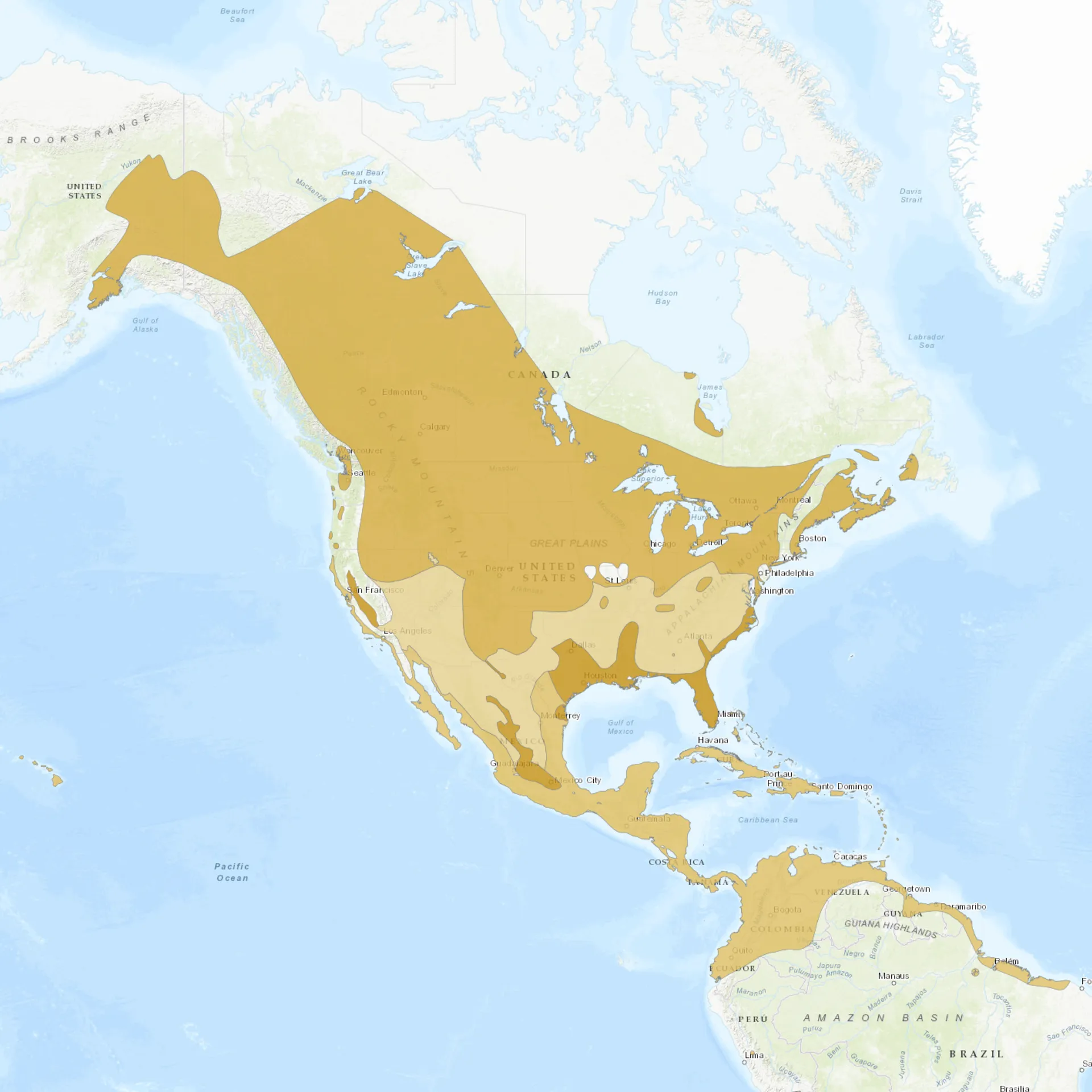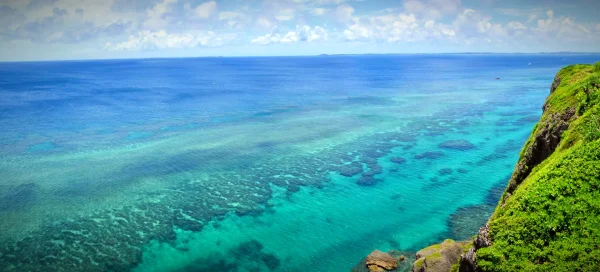Overview
The Blue-winged Teal (Spatula discord) is a small dabbling duck known for its striking plumage and agile flight. Males are easily identified by their bold white facial crescent and speckled brown body. At the same time, females exhibit a more subdued, mottled brown appearance, making them well-camouflaged in their wetland habitats. Both sexes have distinctive blue patches on their forewings, visible in flight, which give the species its name. These birds are among the last to migrate northward in spring and among the first to head south in fall, undertaking long migrations between their breeding grounds in North America and wintering areas in South America.
Blue-winged Teals prefer shallow freshwater ponds, marshes, and wetlands, where they forage for plant matter, insects, and small aquatic organisms. Their small and swift flying capabilities allow them to execute quick turns and rapid flights. Despite their abundance and widespread distribution during breeding, Blue-winged Teals are less conspicuous than other waterfowl, often seeking cover among aquatic vegetation.
The species plays a significant role in wetland ecosystems, contributing to the control of aquatic invertebrates and the dispersal of plant seeds. Conservation efforts focus on preserving wetland habitats essential for the feeding, breeding, and migratory stopover sites of the Blue-winged Teal. Their populations are monitored as indicators of wetland health and the impacts of environmental changes.
Taxonomy
Kingdom
Phylum
Class
Order
Family
Genus
Species
Type
Current distribution:
Blue-winged Teals have a broad distribution, widespread across their breeding range in North America during the spring and summer. In autumn, they migrate south to winter in Central and South America, showcasing one of the longest migratory routes among North American ducks. Their populations are generally stable, benefiting from conservation efforts to preserve wetland habitats.
Despite facing threats such as habitat loss and degradation, Blue-winged Teals remain abundant, partly due to their adaptability and the conservation of critical wetland areas. Ongoing monitoring and habitat conservation efforts are essential to ensure their populations thrive.
Physical Description:
Blue-winged Teals are small ducks, measuring about 37 to 41 cm (14.5 to 16 inches) in length, with a wingspan of 58 to 70 cm (22.8 to 27.5 inches), and weighing between 280 to 500 grams (9.9 to 17.6 ounces). The males are notable for their striking plumage during the breeding season, featuring a bold white crescent in front of their eyes, dark-speckled bodies, and light blue patches on their forewings. Females and non-breeding males are mottled brown, blending well with their surroundings.
Both sexes have a greenish patch (speculum) on their wings, particularly visible in flight. Their bills are small and pointed, adapted for sifting food from water. Blue-winged Teals have short necks and tails, giving them a compact appearance. Their small size and agile flight are adaptations for life in dense, shallow wetlands, where they can easily navigate through vegetation and take off quickly to evade predators.

Lifespan: Wild: ~10 Years || Captivity: ~20 Years

Weight: Male & Female: 9.9-17.6 oz (280-500 g)

Length: Male & Female: 14.5-16 in (37-41 cm)

Wingspan: Male & Female: 22.8-27.5 in (58-70 cm)

Top Speed: 45 mph (72 km/h)
Characteristic:
Native Habitat:
Blue-winged Teals breed throughout North America, from Alaska and Canada southward through the United States to the Gulf Coast and northern Mexico. They prefer shallow freshwater habitats rich in aquatic vegetation, such as marshes, ponds, and wetlands. These environments provide essential resources for nesting, feeding, and protection from predators.
During migration, Blue-winged Teals use a variety of wetlands as stopover sites to rest and refuel. Their wintering habitats extend from the southern United States through Central America to South America, where they inhabit similar wetland environments. The conservation of these wetland habitats along their migratory route is crucial for the species’ long-term viability.
Climate Zones:
Biomes:
WWF Biomes:
Biogeographical Realms:
Continents:
Countries:
Diet:
Diet & Feeding Habits:
Blue-winged teals are omnivores that eat seeds, aquatic plants, and small invertebrates such as insects, crustaceans, and mollusks. They feed by dabbling on the water’s surface or tipping up to reach submerged vegetation, rarely diving. Their feeding habits contribute to the health of wetland ecosystems by controlling insect populations and facilitating the spread of aquatic plants.
In their wintering grounds in Central and South America, Blue-winged Teals adapt their diet to the available food sources, often feeding in rice fields and other agricultural areas, where they can become targets for hunting. Their ability to exploit various food sources across different habitats highlights their adaptability and the importance of diverse wetland ecosystems for survival.
Mating Behavior:
Mating Description:
Blue-winged Teals are monogamous during the breeding season, forming pair bonds that sometimes last only through the breeding season, while others may persist into the migration period. Courtship involves elaborate displays by the male, including vocal calls and physical posturing to attract females. Nesting sites are located in dense vegetation near water, providing concealment from predators.
Females lay 6 to 10 creamy-white eggs, which they incubate for about 24 to 29 days. The male may remain nearby during the early stages of incubation but typically leaves before the eggs hatch. Once hatched, the ducklings are precocial, able to leave the nest within a day and feed themselves, though they remain under the mother’s protection. The female leads her brood to water, where they continue to grow and develop until they are ready to fly.
Reproduction Season:
Birth Type:
Pregnancy Duration:
Female Name:
Male Name:
Baby Name:
Social Structure Description:
Blue-winged teals are social birds outside the breeding season, often forming large flocks during migration and on their wintering grounds. These flocks provide safety in numbers from predators and increase the efficiency of finding food. During the breeding season, they become more territorial, with mated pairs isolating themselves to nest and raise their young.
The social dynamics of Blue-winged Teals, including their flocking behavior and pair bonding, are essential for their survival during migration and breeding, illustrating the complexity of their life history and the importance of conserving their social habitats.
Groups:
Conservation Status:
Population Trend:
Blue-winged Teals are celebrated for their remarkable abundance and extensive distribution throughout North America, a testament to the resilience and stability of their populations. This success is largely due to their remarkable ability to adapt to various wetland habitats, from natural marshes and swamps to man-made ponds and agricultural wetlands. The concerted efforts to conserve and protect these vital wetland areas have played a crucial role in ensuring the species’ prosperity, allowing them to thrive across a wide geographical range.
Despite the general stability, Blue-winged Teals’ populations are not immune to challenges; they experience local fluctuations in numbers, influenced by habitat alterations and shifts in climatic patterns. However, such variations have not led to a significant decline in their overall population, indicating the effectiveness of ongoing conservation strategies to preserve their natural habitats. The ability of Blue-winged Teals to adapt to changing environments, coupled with targeted conservation efforts, continues to support their healthy numbers, showcasing a successful balance between wildlife management and natural adaptation.
Population Threats:
Blue-winged Teals face several significant threats that challenge their populations, with habitat loss and degradation at the forefront. The conversion of wetlands for agricultural use or urban development has led to a marked decrease in the availability of crucial breeding and foraging areas for these ducks. This loss of habitat reduces their living spaces and impacts the quality and diversity of resources available to them, making their survival and reproductive success more difficult.
Additionally, climate change introduces a complex layer of long-term threats to Blue-winged Teals by altering the ecosystems of their wetland habitats. Temperature and precipitation patterns can affect the distribution and abundance of aquatic plants and invertebrates, essential food sources for these birds. Hunting pressure, while regulated, remains a concern in ensuring the species’ sustainability, necessitating stringent management practices to maintain balanced harvest levels without compromising the teals’ populations.
Conservation Efforts:
Conservation efforts aimed at safeguarding Blue-winged Teals are primarily centered around preserving and rehabilitating wetland ecosystems across their extensive breeding, migratory, and wintering territories. Through collaborative initiatives like the North American Waterfowl Management Plan and the international Ramsar Convention on Wetlands, conservationists are working to protect these critical habitats for Blue-winged Teals and many other wetland-dependent species. These concerted efforts play a pivotal role in ensuring the resilience and sustainability of wetland ecosystems, providing vital nesting sites, foraging grounds, and shelter for a diverse array of wildlife.
In addition to habitat conservation, sustainable hunting regulations are meticulously crafted and enforced to prevent overharvesting and ensure the long-term viability of Blue-winged Teal populations. Habitat management programs are implemented to maintain and enhance the quality of existing wetlands, promoting biodiversity and ecosystem health. Public education campaigns further complement these strategies by raising awareness about the importance of wetlands to wildlife and human communities, fostering a culture of conservation and stewardship. Together, these multifaceted conservation measures are crucial for protecting Blue-winged Teals and their rich wetland habitats.
Additional Resources:
Fun Facts
- Blue-winged Teals are among North America’s smallest and most agile ducks. They are known for their swift, twisting flight patterns.
- They have one of the longest migrations of any North American duck, traveling thousands of miles between their breeding and wintering grounds.
- The blue patches on their wings are not always visible at rest but become prominent and beautiful during flight.
- Blue-winged Teals are highly adaptable and can utilize various wetland habitats, from natural marshes to agricultural ponds.
- Despite their extensive migrations, blue-winged teals can be surprisingly hard to spot due to their small size and preference for dense cover.
- They are early migrants, often leaving their breeding grounds before many other duck species begin their autumn migrations.
- The conservation of wetlands benefits Blue-winged Teals supports biodiversity and provides vital ecosystem services such as water filtration and flood control.
- In addition to their dabbling feeding behavior, Blue-winged Teals may also graze on land, eating grasses and grains, especially during migration and in their wintering areas.
- Their distinctive whistling calls can be heard during flight, contributing to the soundscape of the wetlands they inhabit.
- Blue-winged Teals have been recorded diving underwater to escape predators, showcasing their versatility and adaptability in avoiding threats.






















































































